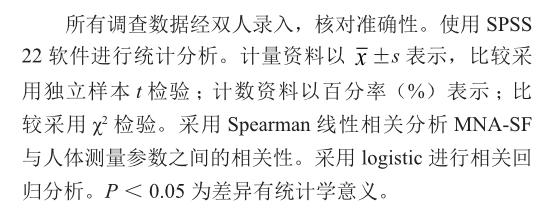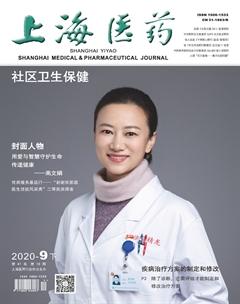社区老年人营养状况与骨质疏松症和肌肉减少症风险的关系
郑熙 李淑梅 方圆



摘 要 目的:探讨老年人的营养状况与骨质疏松症(OP)和肌肉减少症筛查结果之间的关系。方法:以2018年6月15日-2019年7月15日在上海市虹口区江湾镇社区卫生服务中心自愿参加体检的954名60岁及以上的老年人为研究对象,其中男性441人,女性513人。应用微型营养评估简表(MNA-SF)对受试者进行营养评估,使用跟骨定量超声仪测量跟骨的骨密度(T值),通过测量握力(HS)和4米步态速度(GS)来评估肌肉力量与功能。结果:共发现营养不良及营养不良风险者174例(18.2%)。不同营养状况的OP风险分布差异具有统计学意义(P<0.001)。营养状况与GS(r=0.113,P<0.001)、HS(r=0.087,P=0.007)和T值(r=0.185,P<0.001)有显著相关性。结论:营养不良的老年人骨质疏松症和肌肉减少症的易患风险较高,应尽早对该类人群进行高危筛查和确诊检查。
关键词 骨质疏松症;肌肉减少症;老年人;营养状况;筛查
中图分类号:R681 文献标志码:A 文章编号:1006-1533(2020)18-0041-06
The relationship between nutritional status and the risk of osteoporosis and sarcopenia of the elderly in the community
ZHENG Xi1, LI Shumei2, FANG Yuan1(1. General Practice Department of Jiangwan Community Health Service Center, Shanghai 200434, China; 2. Department of Endocrinology of Shanghai Fourth Peoples Hospital, Shanghai 200081, China)
ABSTRACT Objective: To investigate the relationship between nutritional status and screening results of osteoporosis(OP) and sarcopenia in the elderly. Methods: From June 15, 2018 to July 15, 2019 954 elderly persons aged 60 and above who voluntarily participated in medical examinations were taken as the research objects in Jiangwan Community, Shanghai, including 441 males and 513 females. Mini nutritional assessment-short form(MNA-SF) was used to evaluate the nutritional status of the subjects, the bone mineral density(T value) of calcaneus was measured by calcaneal quantitative ultrasound, and muscle strength and function were evaluated by measuring grip strength(HS) and gait speed(GS) of 4 meters. Results: There were 174 cases(18.2%) with malnutrition and malnutrition risk found. The difference in OP risk distribution between different nutritional statuses was statistically significant(P<0.001). Nutritional status was significantly correlated with GS(r=0.113, P<0.001), HS(r=0.087, P=0.007) and T value(r=0.185, P<0.001). Conclusion: Elderly people with malnutrition have a higher risk of osteoporosis and sarcopenia, and high-risk screening and definitive diagnosis should be conducted for this group of people as early as possible.
KEY WORDS osteoporosis; sarcopenia; elderly people; nutritional status; screening
根據国家统计局第六次全国人口普查,2011年60岁及以上人口约为1.8亿,老龄化问题日益严重[1]。营养不良往往会对老年人健康造成严重影响[2]。目前已被证实,营养不良与社区老年人身体机能下降有关[3],如造成骨骼结构和强度的破坏,甚至是肌肉的萎缩[4],最终导致骨质疏松症(Osteoporosis,OP)和肌肉减少症(以下简称“肌少症”)。
OP患者因骨强度下降,和/或肌少症因肌肉力量和活动能力减弱,导致平衡能力下降而跌倒,两者均被认为容易并发脆性骨折,渐已成为全球性健康问题,会给老龄化社会带来沉重的经济负担[5-7]。而且OP和肌少症存在共同的病理生理因素[8]。但目前我国居民对这两种疾病的重视度不够,检查率不高,一旦发生脆性骨折,将严重降低患者的生活质量[9]。因此,评估老年人营养状况是筛查OP和肌少症的重要环节。本文旨在探讨老年人营养状况与OP和肌少症筛查结果的相关性。
OP曾被認为是衰老的自然结果,但它却是一种由于骨量流失而被忽视的疾病[28]。2016年的一项研究显示,我国大陆50岁及以上人群的OP患病率已上升至27.96%[29]。本研究结果显示,83.6%的老年人属于OP中风险和高风险,但年龄与T值无相关性。然而,一项年龄跨度为28岁至90岁的研究表明,无论男性还是女性,随着年龄增长,跟骨超声声速检测会降低[30]。可能原因是年龄跨度较大,涵盖了一部分年龄小于60岁的人群。
本研究发现,T值与HS和GS呈正相关。相关研究也提示肌少症可能与低骨量和OP有关[31]。同时,Locquet等[32]的研究提示,患有肌损伤的老年人骨健康较差。2013年日本一项研究发现,OP女性患者的肌少症患病率达到29.7%[33]。因此,需要对老年人进行常规OP和肌少症风险筛查,以减少肌肉和骨量的损失[34],防止OP和肌少症的发生。
肌少症是与增龄相关的骨骼肌质量减少,并出现肌肉强度下降的疾病,多发于老年人。本研究根据HS和GS的标准,老年人患有肌少症风险的比例分别为16.4%和3.1%,均低于既往研究[35]。可能原因有(1)缺乏更多的筛选指标;(2)本地区经济条件较好;(3)本地区居民生活质量较高,自我健康意识较强。
本研究发现,HS和GS之间存在显著正相关。有人开发了一种新的、简单的肌少症筛查工具[36],内容仅包括年龄、小腿围和HS,并未包含GS,可能是小腿围可部分反映GS的缘故。
参考文献
[1] Statistics NBo. The sixth nationwide population census[EB/ OL]. (2016-09-17) [2019-11-05]. http://www.stats.gov.cn/ztjc/ zdtjgz/zgrkpc/.
[2] Pilgrim AL, Robinson SM, Sayer AA, et al. An overview of appetite decline in older people[J]. Nurs Older People, 2015, 27(5): 29-35.
[3] Hong X, Yan J, Xu L, et al. Relationship between nutritional status and frailty in hospitalized older patients[J]. Clin Interv Aging, 2019; 14:105-111.
[4] Miu KYD, Lam PS. Effects of nutritional status on 6-month outcome of hip fractures in elderly patients[J]. Ann Rehabil Med, 2017, 41(6): 1005-1012.
[5] Moriwaki K, Matsumoto H, Tanishima S, et al. Association of serum bone- and muscle-derived factors with age, sex, body composition, and physical function in community-dwelling middle-aged and elderly adults: a cross-sectional study[J]. BMC Musculoskelet Disord, 2019, 20(1): 276.
[6] Ibrahim K, Mullee M, Yao GL, et al. Southampton Arm Fracture Frailty and Sarcopenia Study (SAFFSS): a study protocol for the feasibility of assessing frailty and sarcopenia among older patients with an upper limb fracture[J]. BMJ Open, 2019, 9(8): e031275.
[7] Matsumoto H, Tanimura C, Tanishima S, et al. Sarcopenia is a risk factor for falling in independently living Japanese older adults: A 2-year prospective cohort study of the GAINA study[J]. Geriatr Gerontol Int, 2017, 17(11): 2124-2130.
[8] Greco EA, Pietschmann P, Migliaccio S. Osteoporosis and sarcopenia increase frailty syndrome in the elderly[J]. Front Endocrinol (Lausanne), 2019, 10: 255.
[9] Ronnow Schacht S, Vendelbo Lind M, Bechshoft RL, et al. Investigating risk of suboptimal macro and micronutrient intake and their determinants in older Danish adults with specific focus on protein intake-a cross-sectional study[J]. Nutrients, 2019, 11(4): 795.
[10] Montejano Lozoya R, Martinez-Alzamora N, Clemente Marin G, et al. Predictive ability of the Mini Nutritional Assessment Short Form (MNA-SF) in a free-living elderly population: a cross-sectional study[J]. Peer J, 2017, 5: e3345.
[11] Katano S, Hashimoto A, Ohori K, et al. Nutritional status and energy intake as predictors of functional status after cardiac rehabilitation in elderly inpatients with heart failure- a retrospective cohort study[J]. Circ J, 2018, 82(6): 1584-91.
[12] Tagliaferri S, Lauretani F, Pela G, et al. The risk of dysphagia is associated with malnutrition and poor functional outcomes in a large population of outpatient older individuals[J]. Clin Nutr, 2018, 38(6): 2684-2689.
[13] Yves Guigoz P, Sylvie Lauque, RD, Bruno J. Vellas, Pr. Identifying the elderly at risk for malnutrition. The Mini Nutritional Assessment[J]. Clin Geriatr Med, 2002, 18(4): 737-57.
[14] Lilamand M, Kelaiditi, E., Cesari, M., et al. Validation of the Mini Nutritional Assessment-Short Form in a population of frail elders without disability. Analysis of the Toulouse Frailty Platform population in 2013[J]. J Nutr, Health Aging, 2015, 19(5): 570-74.
[15] Kaiser MJ, Bauer JM, Ramsch C, et al. Validation of the Mini Nutritional Assessment short-form (MNA?-SF): a practical tool for identification of nutritional status[J]. The Journal of Nutrition, Health and Aging, 2009, 13(9): 782-788.
[16] Tajika T, Yamamoto A, Ohsawa T, et al. Predictors of bone status by quantitative ultrasound measurements in a mountain village in Japan[J]. Open Orthop J, 2016, 10: 559-568.
[17] Chin KY, Low NY, Kamaruddin AAA, et al. Agreement between calcaneal quantitative ultrasound and osteoporosis self-assessment tool for Asians in identifying individuals at risk of osteoporosis[J]. Ther Clin Risk Manag, 2017, 13: 1333-1341.
[18] Chen LK, Liu LK, Woo J, et al. Sarcopenia in Asia: consensus report of the Asian Working Group for Sarcopenia[J]. J Am Med Dir Assoc, 2014, 15(2): 95-101.
[19] Sousa-Santos AR, Amaral TF. Differences in handgrip strength protocols to identify sarcopenia and frailty - a systematic review[J]. BMC Geriatr, 2017, 17(1): 238.
[20] Yang M, Hu X, Xie L, et al. Comparing mini sarcopenia risk assessment with SARC-F for screening sarcopenia in community-dwelling older adults[J]. J Am Med Dir Assoc, 2019, 20(1): 53-57.
[21] Neves T, Fett CA, Ferriolli E, et al. Correlation between muscle mass, nutritional status and physical performance of elderly people[J]. Osteoporos Sarcopenia, 2018, 4(4): 145-149.
[22] Liu LK, Lee WJ, Chen LY, et al. Association between frailty, osteoporosis, falls and hip fractures among communitydwelling people aged 50 years and older in Taiwan: results from I-Lan longitudinal aging study[J]. PLoS One, 2015, 10(9): e0136968.
[23] Alzahrani SH, Alamri SH. Prevalence of malnutrition and associated factors among hospitalized elderly patients in King Abdulaziz University Hospital, Jeddah, Saudi Arabia[J]. BMC Geriatr, 2017, 17(1): 136.
[24] Ghimire S, Baral BK, Callahan K. Nutritional assessment of community-dwelling older adults in rural Nepal[J]. PLoS One, 2017, 12(2): e0172052.
[25] Wong MMH, So WKW, Choi KC, et al. Malnutrition risks and their associated factors among home-living older Chinese adults in Hong Kong: hidden problems in an affluent Chinese community[J]. BMC Geriatr, 2019, 19(1): 138.
[26] Tasci I, Safer U, Naharci MI. Multiple antihyperglycemic drug use is associated with under nutrition among older adults with type 2 diabetes mellitus: a cross-sectional study[J]. Diabetes Ther, 2019, 10(3): 1005-1018.
[27] Nguyen TTH, Vu HTT, Nguyen TN, et al. Assessment of nutritional status in older diabetic outpatients and related factors in Hanoi, Vietnam[J]. J Multidiscip Healthc, 2019, 12: 601-606.
[28] Chin KY. A review on the performance of osteoporosis selfassessment tool for Asians in determining osteoporosis and fracture risk[J]. Postgrad Med, 2017, 129(7): 734-746.
[29] Chen P, Li Z, Hu Y. Prevalence of osteoporosis in China: a meta-analysis and systematic review[J]. BMC Public Health, 2016, 16(1): 1039.
[30] Nagai A, Tajika T, Yamamoto A, et al. Relations between quantitative ultrasound assessment of calcaneus and grip and key pinch power in Japanese mountain village residents[J]. J Orthop Surg (Hong Kong), 2017, 25(1): 2309499017690321.
[31] Santos VRD, Christofaro DGD, Gomes IC, et al. Relationship between obesity, sarcopenia, sarcopenic obesity, and bone mineral density in elderly subjects aged 80 years and over[J]. Rev Bras Ortop, 2018, 53(3): 300-305.
[32] Locquet M, Beaudart C, Bruyere O, et al. Bone health assessment in older people with or without muscle health impairment[J]. Osteoporos Int, 2018, 29(5): 1057-1067.
[33] Miyakoshi N, Hongo M, Mizutani Y, et al. Prevalence of sarcopenia in Japanese women with osteopenia and osteoporosis[J]. J Bone Miner Metab, 2013, 31(5): 556-561.
[34] Padilla Colon CJ, Molina-Vicenty IL, Frontera-Rodriguez M, et al. Muscle and bone mass loss in the elderly population: advances in diagnosis and treatment[J]. J Biomed (Syd), 2018, 3: 40-49.
[35] Reiss J, Iglseder B, Alzner R, et al. Consequences of applying the new EWGSOP2 guideline instead of the former EWGSOP guideline for sarcopenia case finding in older patients[J]. Age Ageing, 2019, 48(5): 719-724.
[36] Tang T, Wu L, Yang L, et al. A sarcopenia screening test predicts mortality in hospitalized older adults[J]. Sci Rep, 2018, 8(1): 2923

